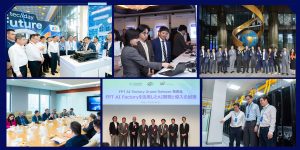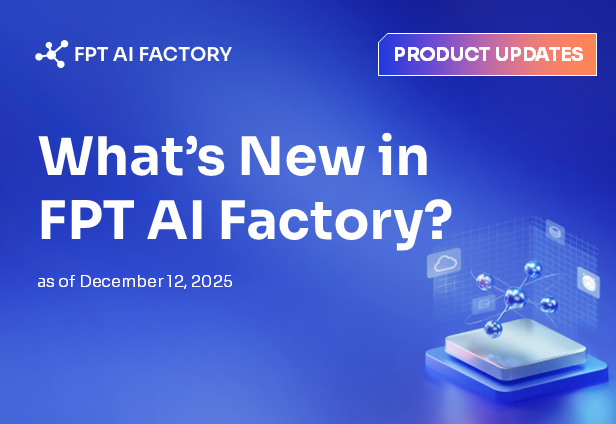FPT AI Factory – $200 Million Bold Bet on Sovereign AI
FPT AI Factory – $200 Million Bold Bet on Sovereign AI

From infrastructure, core products to local talent, FPT AI Factory is laying the first bricks toward Vietnam’s long-term ambition of achieving artificial intelligence (AI) sovereignty.
In April 2024, a simple phrase lit up under the white lights of FPT’s main auditorium in Hanoi: “AI Factory – Make-in-Vietnam”, next to the Nvidia logo. The message was subtle, yet it carried the pride and great aspirations of Vietnamese engineers.
In an era where data is the “new oil” and algorithms dictate competitive power, a Vietnamese corporation investing in AI with infrastructure located in Vietnam, developed by Vietnamese engineers, and focused on meeting the needs of Vietnamese users is no longer just a company’s internal strategy. It is a concrete indication that Vietnam is stepping up to assert its position on the global AI map, not just as a consumer of imported technology, but as a creator of its own.
Decision No. 1131/QĐ-TTg is a strategic push that places AI among the 11 national key technologies. For FPT, it’s a much-needed boost for a dream that has been nurtured for years: mastering core technologies. FPT AI Factory - Vietnam’s first AI factory - is turning that vision into reality: a place where data, algorithms, talent, and ambition come together, gradually transforming Vietnamese intelligence from an idea into strategic national products.
With AI Factory, FPT did not take the safe pathway, but chose AI as a “strategic bet” - investing directly in core capabilities, building compute infrastructure, and developing an open ecosystem not just to serve itself, but to empower the entire business community. From 5-person startups to enterprises with thousands of employees, anyone can access the platform and create their own AI solutions.
With the $200 million investment plan announced in April 2024, FPT is not building another traditional data center, but a factory of intelligence - one that doesn’t produce manufacture hardware or commercial software, but generates the true assets of the future digital economy: computing power, language models, and intelligent agents (AI Agents).
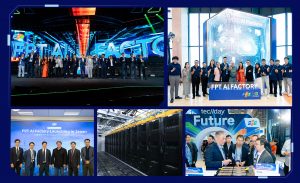
FPT’s “Build Your Own AI” strategy is more than just a tech slogan or a product roadmap. It is a strategic move to narrow the gap with global digital powerhouses. Rather than replicating generic AI models, FPT is building a platform that empowers local organizations to develop AI tailored to their language, user behavior, and local business systems.
This is not just a technological leap, but a strategic choice with multiple layers of meaning. It is all about making AI accessible - not only for engineers, but for those who “may not live by algorithms but live with systems,” from logistics managers to customer service operators.
FPT AI Factory is beyond a tech initiative. It embodies a concept that is gaining global relevance: sovereign AI, where computing power is no longer dependent on external forces, data is not silently exported, and creative potential is no longer trapped in pre-packaged, imported “black boxes” with limited adaptability.
AI Factory - The Infrastructure for the Era of Mass AI
In 2023, an engineer named Pieter Levels built an AI startup from a coffee shop in Bali. This one-man model then generated an annual revenue of $1 million. Another anecdote that caught widespread attention tells of a programmer who used GPT-4 to create an entire interactive adventure game within a few hours… while waiting for his wife to give birth in the hospital.
With the launch of ChatGPT, AI has broken free from the inertia of linear growth to an era of exponential breakthroughs. In just five years, AI has evolved from a specialized concept into a foundational tool as ChatGPT writes emails, Midjourney creates visuals that even professional artists admire, and Copilot becomes a companion for developers who half-jokingly call it “organized laziness.” Many AI-embedded applications have been steadily making their way into every enterprise software, collaborative platform, and creative tool, enabling people to make faster, more accurate decisions and complete their work more efficiently.
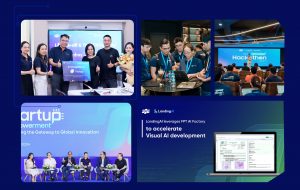
The presence of AI does not come with a bang; it spreads quietly through millions of small clicks each day. That is when someone edits a document, schedules a meeting, analyzes a customer report… all with AI silently running in the background.
What once required a team of engineers now fits neatly inside a browser. This shift is more than a sign of a tech trend - it’s a signal that AI has become part of the digital infrastructure, weaving its way into every corner of daily life.
In this context, no-code/low-code AI platforms, which allow non-programmers to build intelligent solutions, are reshaping the full picture of digital transformation. According to Mordor Intelligence, this market is expected to reach $8.89 billion by 2030, with a compound annual growth rate (CAGR) of 17.03%.
At the same time, the concept of AI Agents - autonomous agents capable of independently executing tasks within an organization - is gaining just as much traction, with a market value projection of $52.62 billion by 2030 (According to MarketsandMarkets).
The rise of these platforms means that AI is no longer a resource for researchers or Big Tech; it is now a tool that can be deployed at any scale. With just a few clicks, a non-expert can create a customer service chatbot, a data classification system, or even a personal digital assistant - those once necessitated an entire team of engineers.
Yet, this democratization brings new demands for infrastructure. Large language models like DeepSeek-R1 with 671 billion parameters would require immense computational resources to run effectively if the architecture is not optimized. By using the Mixture of Experts (MoE), which activates only a portion of the model during each inference, DeepSeek-R1 has decreased computing costs by up to 94% while maintaining high accuracy.
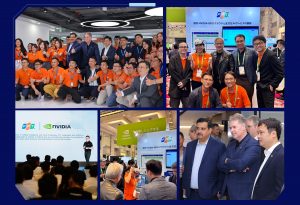
This is where the AI Factory model becomes essential for a production line for AI capabilities, where every step from data collection, training, fine-tuning, deployment, and operation is optimized like an industrial process.
The key differentiation is not hardware, but in the guiding philosophy of developing localized AI models that understand not only the language but also behaviors, customs, and organizational dynamics of each market.
In Vietnam, those models can comprehend Vietnamese, including unique syntax and contextual nuances, to effectively support public administration, customer service, or local financial operations. But this approach extends beyond the border of the S-shaped country. In Japan, FPT is partnering with Sumitomo and SBI Holdings to build a second AI factory, aiming to support and collaborate with local players in developing “sovereign AI” capabilities, customized to the social fabric and strict standards of the Japanese market.

That means, each time FPT enters a new country or market, it does not apply a one-size-fits-all model. Instead, the corporation proactively approaches and localizes from data to product design. With a presence in over 30 countries and territories, FPT has accumulated a wealth of local insights, allowing its AI solutions to truly fit the needs of local users, exactly in line with the “Build Your Own AI” strategy.
Globally, this shift is already well underway. For instance, the Japanese government has invested $740 million to build a domestic AI factory in collaboration with Nvidia, striving to ensure infrastructure independence (Nvidia Blog). Meanwhile, the European Union plans to fund 20 large-scale AI factories between 2025 and 2026 (Digital Strategy EU). The telecom giant Softbank has also committed over $960 million to developing its own domestic AI infrastructure.
Amid this global momentum, Vietnam needs an adequate approach. We may not be able to compete in terms of scale with the U.S. or China, but we can differentiate ourselves by building infrastructure that is lean, agile, and attuned to local users.
FPT has made the first bold move by investing in core capabilities, developing platforms for Vietnamese businesses, and contributing to a future where AI is not an option, but a prerequisite for economic growth and national competitiveness.
From Strategic Vision to a Sovereign AI Ecosystem
Beyond demonstrating its internal capabilities, FPT’s partnership with Nvidia indicates a forward-looking commitment to a direction that many countries have yet to fully pursue.
Departing from the conventional path, FPT AI Factory is designed to produce AI capabilities, from data collection and model training to inference and deployment.
In just one year, this approach has been brought to life through high-performance GPU infrastructure, no-code/low-code platforms, and an open ecosystem that enables businesses to access AI as a service - no need for hardware investment, no dedicated technical team - yet still capable of delivering intelligent tools that meet real-world needs.
This is not AI for show, but a deployable capability at scale, aligned with the “make-in-Vietnam” spirit, spanning from computing power to language models and localized solutions.
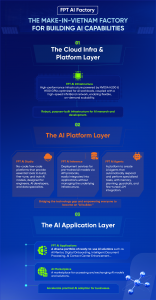
An HR specialist can build a chatbot to answer questions about company policies, a logistics manager can train a model to analyze inventory risks, and a customer service representative can use AI to categorize and respond to emails. They do not need to know how to write a loss function or select an optimizer - the kinds of technical barriers that have long kept most people from accessing AI, but practical problems and real data.
One of the defining features of FPT’s AI platform is its deep adaptability to local contexts, including language, user behavior, and operational structures. Models are trained on formal datasets specific to each target market, enabling them to accurately understand linguistic nuances, workflows, and industry characteristics. Instead of requiring businesses to overhaul their core systems, AI services can be flexibly integrated with existing infrastructure, from CRM and ERP to internal platforms, allowing AI to operate as a natural extension of an organization’s current technology ecosystem.
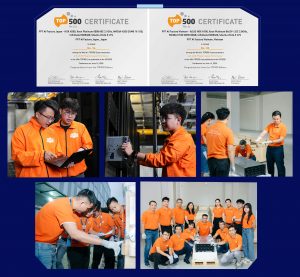
This strategy helps safeguard data, shorten deployment time, and maintain on-site technological control - core elements for building sovereign AI capabilities that transcend the boundaries of a single nation. With an open architecture and a localization-first mindset, this model can be quickly replicated across international markets with similar needs.
The capabilities of FPT AI Factory have also been recognized through global benchmarks. On the TOP500 list of the world’s most powerful supercomputers (LINPACK benchmark), FPT’s systems currently rank 38th in Vietnam and 36th in Japan - a solid foundation for entering performance-intensive markets.
The stature of an AI factory is also reflected in its ability to attract global partners. A standout example is LandingAI - a company founded by Andrew Ng, well known for its enterprise Visual AI platform.
As it expanded to new markets, LandingAI chose to deploy its image inference tasks on the Metal Cloud from FPT AI Factory. Thus, they significantly lower costs and reduce model deployment times from several weeks to just a few days - a critical advantage for businesses pursuing rapid growth.
A single year may not seem long in the tech industry, but in the world of AI, where change happens exponentially, it is enough time to chart a path forward. While much of the world is still finding its footing, FPT made an early bet on practical AI infrastructure, not just to keep pace with global trends, but to deliver real value quickly, certainly, and strategically: building AI in a way that fits local markets and opens the door to autonomy in what is widely seen as the “power game” of the 21st century.
“Build Your Own AI” Strategy – FPT Opens Infrastructure, Enterprises Take Control of the Digital Future
FPT’s announcement to build 5 AI factories globally by 2030 is not a publicity stunt, but a firm commitment to go the distance in the technology race: investing in robust AI infrastructure while simultaneously developing a ready, capable AI workforce as a core competency.
On the “hard” aspect, FPT currently operates one of the region’s most powerful AI computing systems, partners with global leaders like Nvidia, and continues to expand its capabilities in both Vietnam and Japan. But as Dr. Truong Gia Binh, FPT Chairman, shared, “The world is facing a serious talent shortage, and that is where FPT holds an advantage.” Therefore, the “soft” component of this strategy focuses on education and widespread AI literacy, preparing students, engineers, and operational experts across industries with the skills to use and integrate AI at scale.
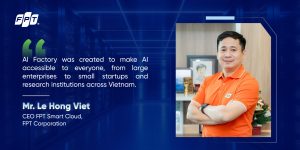
FPT perceives this as a journey that fuses the computational power of machines with the thinking and adaptability of humans to craft breakthrough solutions.
“As AI becomes more accessible and democratized, the greater the demand will be for AI factories. We will not stop at just two factories because many global corporations have already approached us to collaborate,” said Mr. Trương Gia Bình.
Starting from infrastructure and data, while the world races to train models with trillions of parameters, even a 32-billion-parameter model requires around 400 billion tokens to train. For comparison, a human processes only about 50–100 million language tokens in a lifetime. As Vietnam’s digital data remains fragmented and lacks transparent sharing mechanisms, it presents a significant challenge for building localized AI capabilities.
The solution stems from the unique data Vietnam already possesses: healthcare, education, and insurance. Once these sectors are fully digitized, we can not only build models that reflect local realities but also proactively improve public health and optimize public services.
Data sovereignty, then, is not just a slogan. It is a national strategic imperative. It requires robust digital infrastructure, transparent data-sharing mechanisms, and a long-term commitment to building AI platforms that serve the interests of the Vietnamese people.
According to Mr. Le Hong Viet, CEO of FPT Smart Cloud, FPT’s decision to invest directly in Vietnam is about more than building high-performance computing infrastructure. It is driven to address a key bottleneck in the domestic market and move AI out of experimental labs into practical use for every business.
”AI Factory was created to make AI accessible to everyone, from large enterprises to small startups and research institutions across Vietnam”, said Mr. Viet.
For FPT, he added, AI is not just a tool for boosting internal productivity or delivering value to clients. It is a strategic arena for establishing Vietnam’s position on the global technology map. The AI-first mindset has been embedded in FPT’s DNA from the beginning and is now serving as the guiding principle for its next stage of growth. Infrastructure is only the starting point: the real challenge revolves around technology transfer. This is why FPT is pursuing a parallel investment strategy: bringing the most advanced Nvidia chips to Vietnam, developing tools that help businesses fine-tune their own models at low cost, and training a workforce for both operation and deep research.

Mr. Viet further stated that fine-tuning an AI model used to cost tens of thousands of dollars, but now, with FPT’s services, businesses can sink down that cost to a few hundred dollars or even adopt a “pay-as-you-go” model, paying only for what they use. This grants access to cutting-edge technologies for small businesses, universities, and research institutions - those that are often left behind in the global AI surge.
At the same time, FPT is not hiding its ambition to expand the AI Factory model internationally, starting with Japan, one of the world’s most digitally advanced economies, yet still lacking compatible specialized AI infrastructure. Following Japan, FPT aims to accelerate expansion into markets such as Malaysia, South Korea, and Europe.
“We are entering the Japanese market to stay ahead of the wave of AI adoption. FPT will operate as a truly Japanese company to promote the development of sovereign AI in Japan,” Mr. Viet said.
With the involvement of partners like Sumitomo and SBI Holdings, the AI Factory in Japan will not be a replica of the Vietnamese model, but a fully localized entity, from organizational structure to integrated ecosystem.
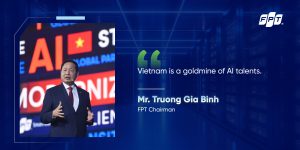
At the strategic level, Mr. Le Hong Viet put it plainly: “The strategy of promoting sovereign AI will enhance Vietnam’s national competitiveness by amplifying productivity and accelerating automation.”
In a country like Vietnam, where data is becoming a core asset, relying on foreign platforms means losing control over the value of such data. Sovereign AI, therefore, is not a theoretical ideal; it is a form of digital self-defense. It ensures that every piece of data is processed, stored, and operated on platforms developed by Vietnamese people, for the benefit of Vietnamese people.
However, without a skilled workforce ready, even the most advanced technology will remain just infrastructure, and FPT understands this clearly.
“Training talent at all levels is the most critical factor in the intelligent transformation journey,” Mr. Viet emphasized.
FPT AI Factory is a bold challenge and, simultaneously, a playground to attract talent, develop a highly prepared AI workforce, and embed an AI-first mindset across the organization. From business leaders (Level 1), to employees who use AI as a tool (Level 2), and further to training for AI engineers (Level 3), FPT has set the goal of training 500,000 AI-capable professionals over the next 5 years.
From infrastructure to human capital, from domestic challenges to the global landscape, FPT is not standing on the sidelines of the AI evolution. It has chosen to invest, to deploy, and to let real-world results speak louder than promises.
“What sets FPT apart is that we do not build AI for show - we build it to deploy. And we use this very platform in our own operations,” Mr. Viet affirmed.
At a time when any AI model can be technically replicated, the ability to make those models actually work, in context, for real users is the long-term edge FPT is working to define.
One year after the launch of FPT AI Factory, FPT is laying the foundation for a future where AI is not just a business advantage but a driver of national competitiveness. The journey may be long, but through each and every step, FPT is making one thing clear: Vietnam can be technologically self-reliant and ready to seize opportunity at critical turning points.
